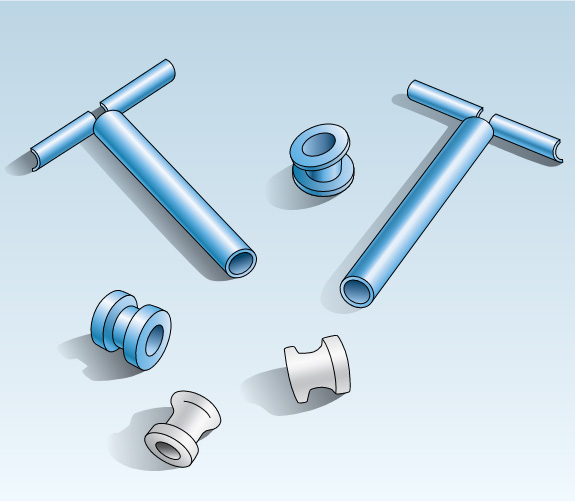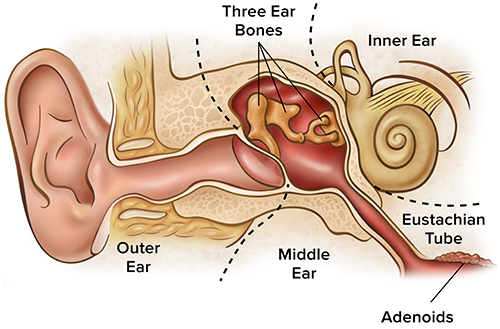Ear Tubes
Download Ear Tubes information sheet (PDF)
Ear infections

Ear infections are one of the most common reasons for doctor visits, and the most common reason to receive medicine as a child. Many ear infections either resolve on their own (viral) or are effectively treated by medicines that fight infections (bacterial). Frequent ear infections or long-lasting fluid in the middle ear can cause long-term problems including hearing loss, and in the case of children, difficulties with speech and language development. In these cases, insertion of an ear tube by an otolaryngologist (ear, nose, and throat specialist) may be considered.
What are ear tubes?

Ear tubes are tiny plastic or metal cylinders placed in the ear drum (tympanic membrane) to hold a small area of the ear drum open. Other names for ear tubes are tympanostomy tubes, myringotomy tubes, ventilation tubes, or PE (pressure equalization) tubes.
These tubes come in different shapes and sizes, generally designed to be either shorter or longer-lasting. Short-term tubes are smaller and typically stay in place between six to eighteen months before falling out on their own. Longterm tubes may stay in place for many years.
Ear tubes are often recommended when a person experiences repeated middle ear infections (acute otitis media) or has hearing loss caused by long-term middle ear fluid (otitis media with effusion). Ear tubes also help reverse the effect of pressure from Eustachian tube dysfunction, such as retraction of the ear drum. Children with certain conditions, such as Down syndrome or cleft palate, may be more likely to need ear tubes.



figures 1: Long-term middle ear fluid (otitis media with effusion) figures 2: Retraction of ear drum (tympanic membrane) figures 3: Tube in place (with ear drum in normal position and no fluid)

Ear tube placement is the most common childhood surgery performed with anesthesia. The average age for ear tube insertion is one to three years old. Inserting ear tubes may:
- Decrease the likelihood of future ear infections.
- Allow future ear infections to be treated with ear drops rather than pills.
- Restore hearing loss caused by middle ear fluid.
- Prevent hearing loss over time from long-term infections.
- Improve speech and balance problems.
How are ear tubes placed?
Adults have ear tubes placed in clinic, often after a numbing medication is applied to the ear drum. Children, on the other hand, require general anesthesia (medicine used during surgery to put you to sleep).
Under a microscope, a small opening is made and the fluid behind the ear drum is removed. The ear tube is then placed in the opening to keep the hole open. The procedure usually lasts less than 15 minutes.
What happens after surgery?
If the procedure is done in the operating room, the patient is cared for in the recovery area for a short period of time. Pain after the ear tubes are placed is usually mild. Children may be sleepy or fussy afterwards.
Hearing loss caused by fluid in the middle ear is immediately helped by surgery. Children with speech, language, learning, or balance problems may not experience changes right away. Ear drops will typically be prescribed for a few days to prevent infection or blockage of the tubes after placement. A hearing test (audiogram) is frequently recommended after surgery, especially if there was hearing loss prior to surgery.
Your surgeon will specify whether precautions while swimming or bathing are necessary after surgery. If restrictions are recommended, earplugs and head bands can be used to protect the ears from being exposed to water. The risk of ear infection is typically less with pool water compared to lake or river water.
Possible issues after surgery

Ear tube insertion is an extremely common and safe procedure with minimal complications. If complications occur, they may include:
- Infection: Ear infections can still occur with a tube in place and cause ear drainage. These infections are typically treated and cured with antibiotic ear drops.
- Scarring: Any irritation of the ear drum – from ear infections or surgery – can cause scarring. In most cases, this causes no problem with hearing and does not need any treatment.
- Ear tubes come out too early or stay in too long: If an ear tube becomes obstructed and/or expels from the ear drum too soon, fluid may return and repeat surgery may be needed. Ear tubes that remain too long may result in perforation (a hole in the ear drum) or may require removal by an ear, nose, and throat specialist.
- Perforation: A hole in the ear drum can sometimes occur when the site of the tube in the ear drum does not heal after the tube comes out. This perforation can be patched with a surgical procedure.


